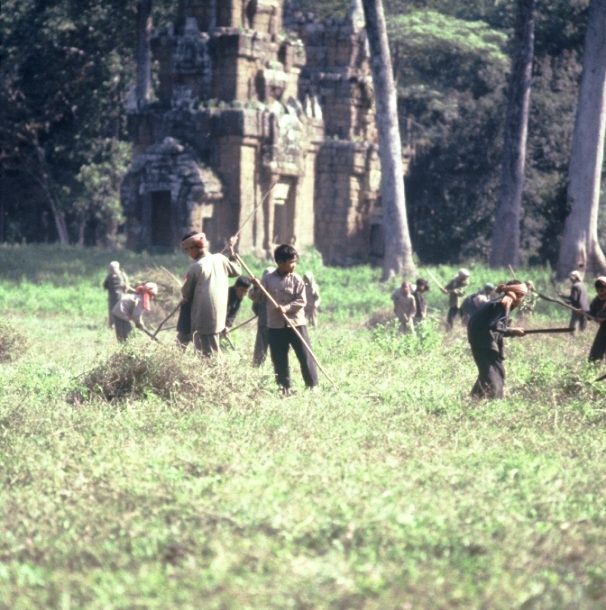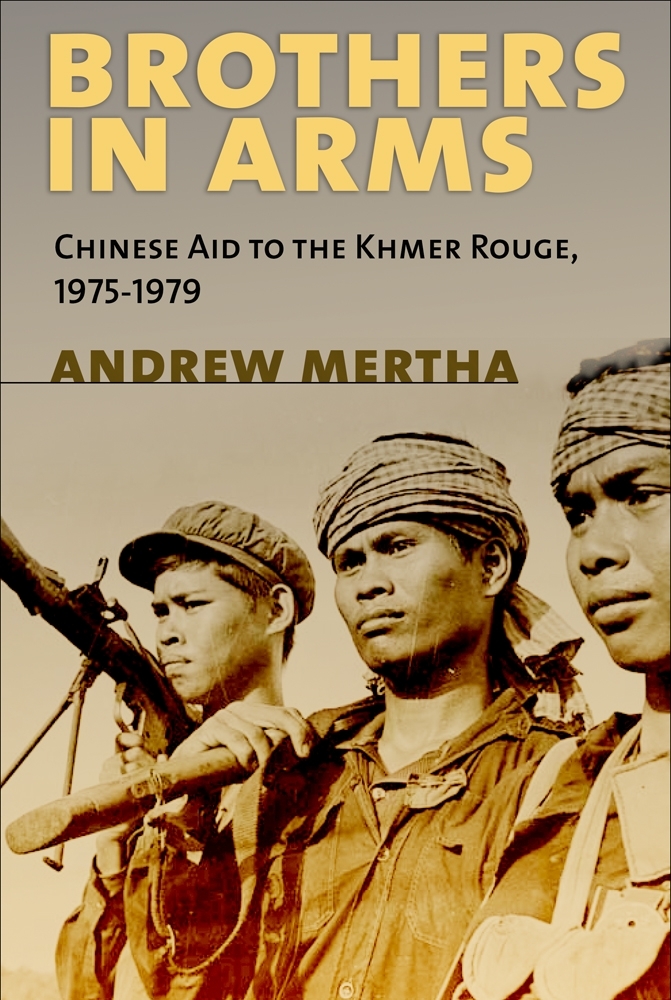Andrew Mertha, Brothers in Arms: Chinese Aid to the Khmer Rouge, 1975-1979.
Ithaca and London: Cornell University Press, 2014. Pp. xvi, 175; note on transliteration, illustrations, notes, glossary, index.
Reviewed by Ian Storey.
Andrew Mertha’s superb book is 35 years overdue. While it has long been appreciated that it was support from China that enabled the Communist Party of Kampuchea, aka the Khmer Rouge, to seize power in 1975 and to brutalize Cambodia until it was ousted by Vietnam in 1979, this is the first detailed study of how Beijing disbursed its aid and of the clash of bureaucratic cultures which ensued. It was this failure of bureaucratic politics which, the author convincingly argues, stymied Beijing’s attempts to turn Democratic Kampuchea (DK) into a client state or even a reliable ally over which it could exert decisive influence.
Before going on to describe the main thesis of Brothers in Arms,it is worth highlighting one of the book’s most important subthemes: to what extent was China complicit in the Khmer Rouge’s murder –either directly or indirectly– of 1.9 million Cambodians during its three-and-a-half year reign of terror? Mertha argues that, because China propped up the DK regime from beginning to end, it is clearly guilty of “indirectly contributing to the vast human rights abuses and mass killings that became the defining feature of DK” (p. 16). But what about the thousands of Chinese advisers and technicians who were sent to DK to administer aid? How complicit were they? On this point Mertha paints a nuanced picture. Yes, fresh from the violent excesses of the Cultural Revolution, the “political antennas” of the Chinese advisers were acute enough to tell them that “something sinister was afoot” (p.57) even if they were not aware of the full scale of the atrocities. Yet they kept silent, fearful of the repercussions should they speak out and unconvinced anyway that they could put a stop to what was happening. But, in contrast to the brutality of DK cadres, all of Mertha’s Cambodian interviewees unanimously agreed that the “only glimmerings of humanity” that they experienced during the dark days of Khmer Rouge rule were “uniformly extended to them by the Chinese expatriates”, often at great risk to themselves (p. 18). Thus, when it comes to aiding the Khmer Rouge’s genocide the Chinese government is guilty as charged, while Mertha portrays those tasked with helping Cambodians on the ground in a much more positive and sympathetic light. It is one of the few bright spots in this otherwise sad and harrowing tale.
So what did Beijing derive from the vast amounts of financial, military and technical aid that it poured into DK from 1975 until 1979? According to the author, except for a damaged reputation –from which China continues to suffer today, despite strenuous attempts to downplay its support for the Khmer Rouge–the answer is not very much at all. The author’s central argument is that China’s meagre returns were due primarily to “bureaucratic fragmentation in China combined with an institutional matrix in Cambodia strong enough to resist Chinese demands or too weak to act on them” (p. 9).
In Chapter 2 of Brothers in Arms, Mertha provides a highly detailed but readable account of the DK bureaucracy, its various ministries and their idiosyncrasies, and in Chapter 3 a fascinating examination of the structure of China’s overseas assistance. He then goes on to illustrate his thesis with three case studies: military aid, infrastructure support, and trade assistance.
As detailed in Chapter 4, China provided DK with the full panoply of military equipment, including tanks, artillery, aircraft patrol boats and surveillance and communication equipment, as well as the training needed to operate it. Mertha focuses, however, on the massive Krang Leav airfield which China designed and whose construction it oversaw, but which was built by forced labour. [Chillingly, the author reveals that “Villagers recalled that the smell of corpses lingered for a decade” (p. 77)]. Yet, because the military was one of the strongest institutions in DK, it was able to deflect Chinese attempts to influence the country’s defence policy, including even the location of Krang Leav. Thus, when it came to military aid, far from being the dominant actor China is portrayed as the subordinate party.
In Chapter 6 Mertha describes how China prioritized the refurbishment of the Kampong Som petroleum refinery in its efforts to rebuild the country’s infrastructure. This effort proved, however, “one of the most spectacular failures” of China’s support for the DK (p.98). The refinery project failed, first, because DK institutions were incapable of managing complex tasks. Skilled Cambodians had been purged, and most of the workers and even those in supervisory positions were thus mere children. Second, Chinese institutions in charge of energy policy were so fragmented that they were incapable of effectively planning and coordinating the technical and managerial aspects of the project. Mertha speculates that, even if the Vietnamese had not invaded Cambodia and toppled the Khmer Rouge regime, the refinery would never have operated successfully.
Only when it came to trade assistance, as Mertha argues in Chapter 6, was China able to exert some influence over DK, mainly because it was able to “colonize” the country’s Ministry of Commerce “structurally and procedurally” (p. 120) and also because there were competent bureaucrats on each side. Thus, ironically, it was only in the area of trade that the two communist countries achieved harmony and results.
In the final chapter of Brothers in Arms, the author attempts to discern what China’s aid to DK can tell us about its support for developing countries today. At least for this reviewer this was the least satisfying part of the book. Mertha posits that the bureaucracy which manages China’s overseas development aid today is “at least as fragmented” as it was during the 1970s and that China’s military is “more fragmented” (p. 138). I have no knowledge of the former, but when it comes to the latter it is clear that the People’s Liberation Army is vastly different to what it was in the 1970s–a more professional, integrated and lethal force. Further, at least under President Xi Jinping China’s defense policy has become increasingly centralized, coordinated and proactive, as recent events in the South and East China Seas have demonstrated. Mertha’s argument resembles what it would be like arguing that the US military today is basically the same institution which was defeated in the Vietnam War: clearly, it is not. Mertha’s point is, nevertheless, a good one: portrayals of China as an unstoppable economic juggernaut led by master strategists who can run rings around other countries and influence their foreign policies should be taken with a pinch of salt.
In summary, Brothers in Arms is a masterful account of China’s failed policy of support for Democratic Kampuchea, required reading for anyone who wishes to understand either Beijing’s role in Southeast Asia during the 1970s or the decisive influence of bureaucratic politics.
Ian Storey is Senior Fellow at the Institute of Southeast Asian Studies (ISEAS) in Singapore and editor of Contemporary Southeast Asia.
 Facebook
Facebook  Twitter
Twitter  Soundcloud
Soundcloud  Youtube
Youtube  Rss
Rss 
